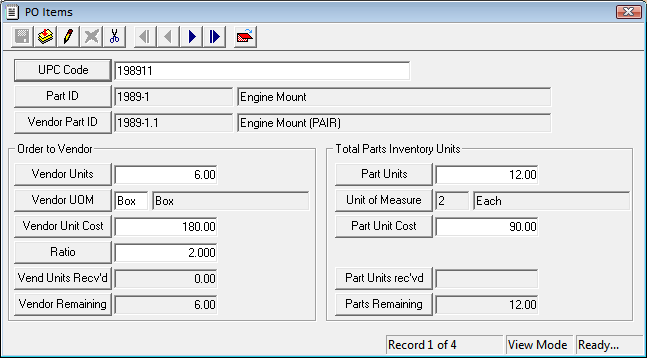
PO Items records display identifying information for a part, order quantities, cost, and any unit conversions required between the agency and the vendor.

Identification Information
Three fields at the top of the screen track information used to identify the part being ordered. This information comes from the Vendor record associated with the part.
UPC Code |
The Universal Product Code (UPC) for the part (from the Vendors > Vendor Parts grid > UPC Code field). |
Part ID |
The agency's ID for the part (from the Vendors > Vendor Parts grid > Part ID field). |
Vendor Part ID |
The vendor's ID for the part (from the Vendors > Vendor Parts grid > Vendor Part ID field). |
Order to Vendor Information
The Order to Vendor fields display information that pertains to the order.
Vendor Units |
The number of units being purchased. |
Vendor UOM |
The unit of measure in which the vendor measures the units. This value comes from the Vendors > Vendor Parts grid > Vendor UOM field. |
Vendor Unit Cost |
The price the vendor charges per unit. This value comes from the Vendors > Vendor Parts grid > Vendor Unit Cost field. |
Ratio |
The ratio comparing the vendor's and agency's units for the part. This ratio comes from the Vendors > Vendor Parts grid > Ratio field. Example: In the screenshot above, the Ratio is 6. That means, for every one crate of oil purchased, the agency adds six quarts to its inventory. |
Vend Units Recv'd |
The number of Vendor Units received. An agency fills out this field when it records a complete or partial shipment of the part. |
Vendor Remaining |
The number of Vendor Units not yet received. An agency fills out this field with the number of items remaining when it records a partial shipment of the part. |
Total Parts Inventory Units
The fields in the Total Parts Inventory Units section are used to convert the vendor's units into the agency's units. This is useful because often vendors sell an item based on a different quantity than the agency uses the item.
Example: In the image above, the vendor sells oil by the crate. The agency doesn't use oil by the crate, it uses it by the quart. So, a conversion is required to show that when the agency orders case, its inventory actually increases by six quarts.
Part Units |
The number of units being purchased based on the agency's unit of measurement. Automatically calculated as: Vendor Units x Ratio; however, users can also enter this value manually. |
Unit of Measure |
The unit of measurement that the agency uses for the part (from the Vendors > Vendor Parts grid > Unit of Measure field). |
Part Unit Cost |
The price of each part based on the agency's unit of measurement. Automatically calculated as: [Vendor Units x Vendor Unit Cost]/Part Units; however, users can also enter this value manually. |
Part Units Rec'vd |
The number of Part Units received. An agency fills out this field when it records a complete or partial shipment of the part. |
Parts Remaining |
The number of Part Units not yet received. An agency fills out this field with the number of items remaining when it records a partial shipment of the part. |